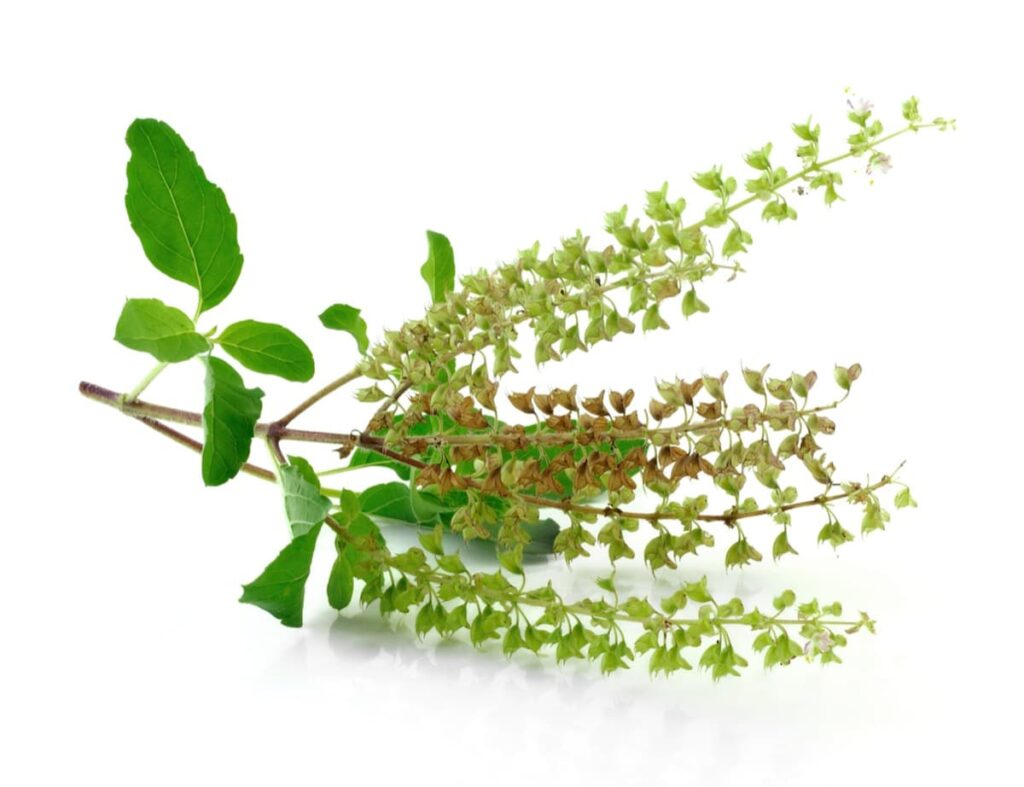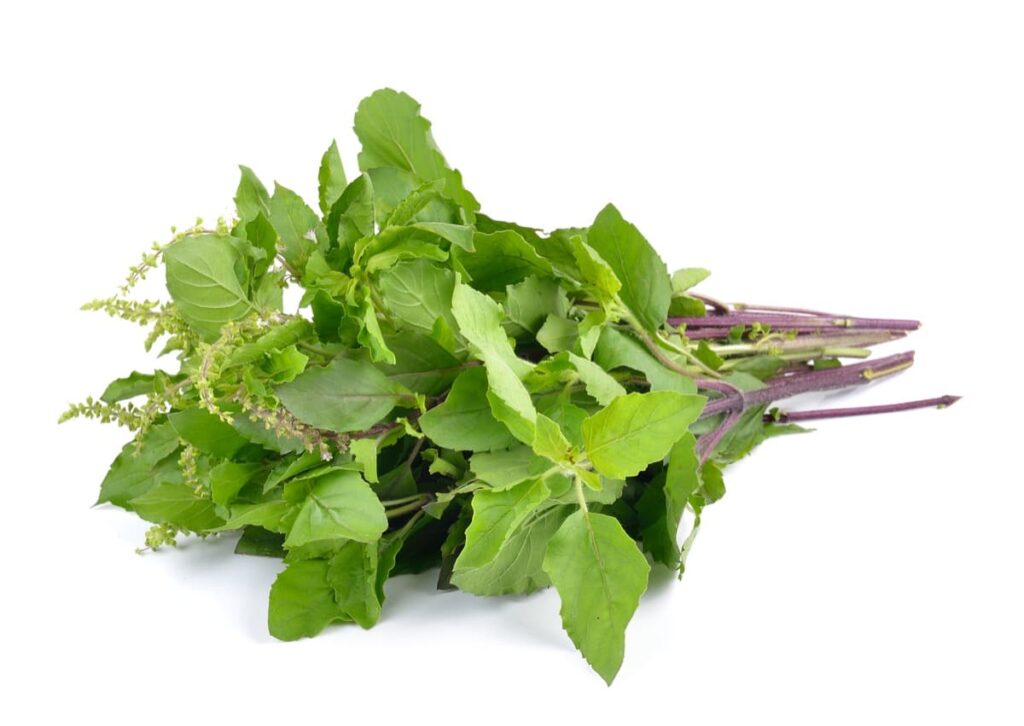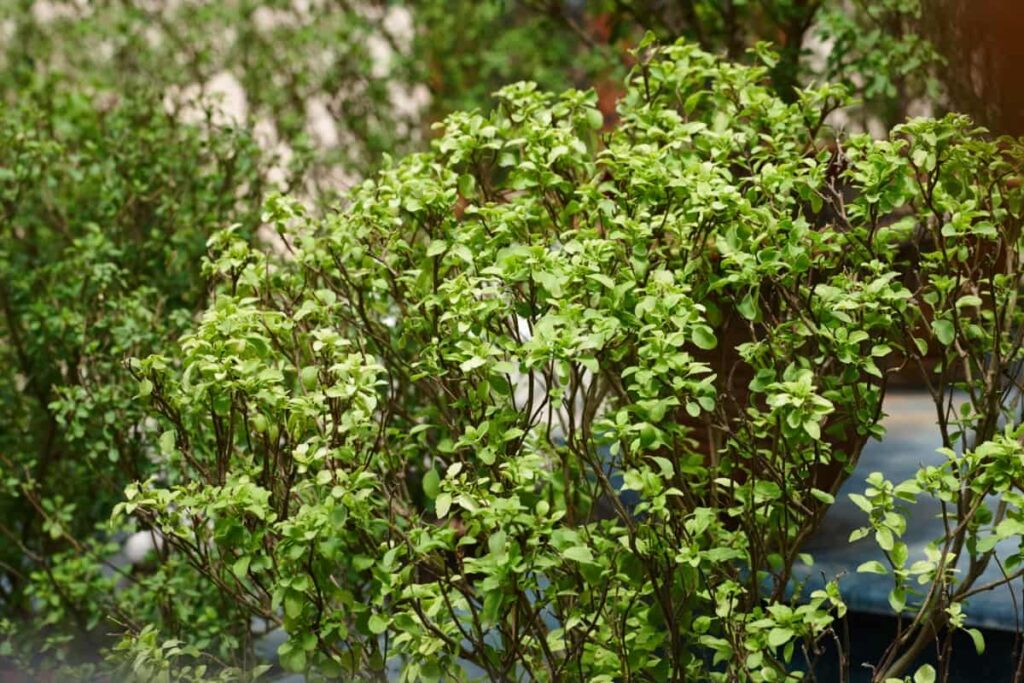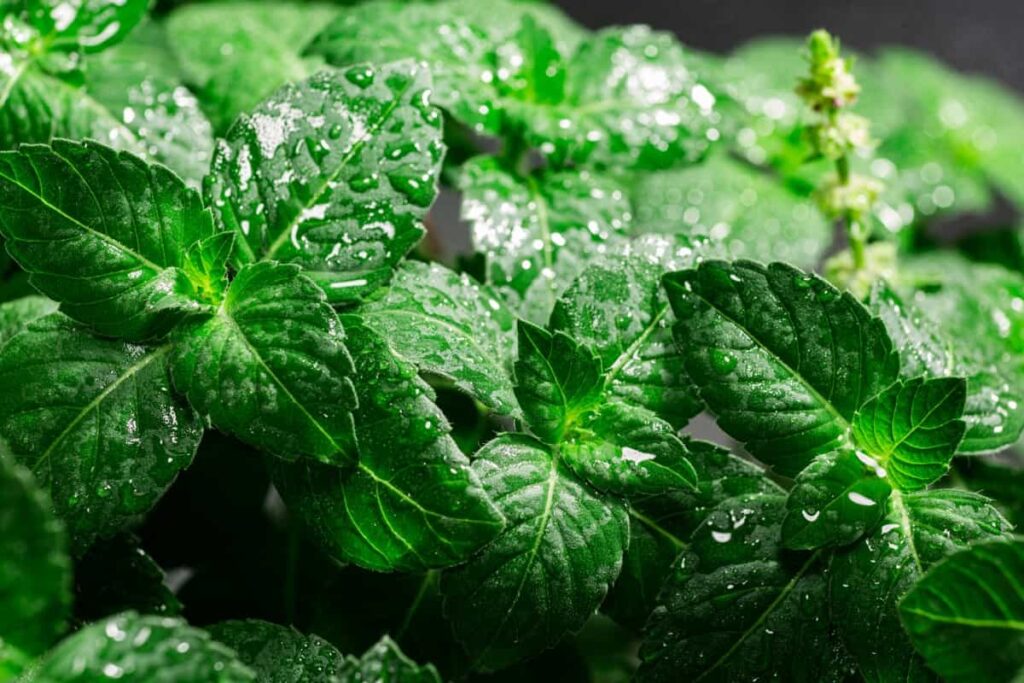Tulsi, also known as Holy Basil, sacred basil. It is a herb that has been revered in India for thousands of years for its medicinal and spiritual properties. Tulsi is considered sacred in Hinduism and is used in various religious rituals. However, in recent years, Tulsi farming has gained popularity not only for its spiritual significance but also for its profitability. In this guide, we will explore the profitability of Tulsi farming and provide a comprehensive guide and business plan for maximizing profits.

Tulsi Farming Business Plan
What is Tulsi Farming?
Tulsi farming is cultivating the herb Tulsi (Ocimum sanctum), also known as Holy Basil, used in Ayurveda and traditional medicine for its medicinal and spiritual properties. Tulsi is a hardy perennial plant that can be grown in different soils and climates. It requires warm temperatures and regular watering. Tulsi is a high-value crop in India due to its high demand for use in religious rituals and its medicinal properties. Tulsi farming is a profitable business, and its popularity is increasing due to the increasing demand for Tulsi.
Know More About Tulsi
- Holy basil is a hairy, upright, multi-branched subshrub 30–60 cm (12–24 in) tall. Green or purple leaves are simple, petioled, oval, up to 5 cm (2 in) long, intensely perfumed, and decussate.
- Elongated racemes have purple flowers in close whorls. Three main types of Tulsi are cultivated in India and Nepal: Ram Tulsi, Krishna or Shyam Tulsi, and wild Vana Tulsi.
- The plant has now naturalized into a cosmopolitan distribution. Tulsi contains several phytochemicals, including eugenol, carvacrol, linalool, and β-caryophyllene, and aroma compounds such as camphor, eucalyptol, and β-bisabolene.
In case you missed it: How to Earn 1 Lakh Per Month from Tulsi: 1 Acre Holy Basil Cultivation/Farming/Production Project Report, Cost, Profitability Analysis

Benefits of Tulsi Farming Business
- Tulsi has many health benefits, and the demand for Tulsi products is increasing gradually due to its medicinal properties.
- Tulsi plants are hardy and generally less susceptible to diseases, making it easier to cultivate them.
- Tulsi farming requires relatively low investment costs, but the return on investment is high, with the ability to recoup invested money quickly.
- Commercial Tulsi farming yields two major products, the seeds, and the leaves, making it a profitable agribusiness.
- Tulsi farming can be done in almost any soil type, making it a versatile crop that can be grown in many regions.
- Tulsi farming can provide employment opportunities for unemployed educated people and be a good source of income for them.
- The Tulsi plant purifies the air, provides oxygen continuously, and benefits the environment, making it a sustainable and eco-friendly farming option.
Popular Tulsi Varieties
- Rama Tulsi: This variety has green leaves and a slightly sweet taste. It is commonly used in Ayurvedic medicine for its calming and soothing effects.
- Krishna Tulsi: This variety has purple leaves and a peppery taste. It is high in antioxidants and is used to boost the immune system.
- Vana Tulsi: This wild variety has a strong aroma and is often used for its medicinal properties. It is a popular choice for herbal teas and is known for its anti-inflammatory and anti-bacterial properties.
- Kapoor Tulsi: This variety has a distinct aroma and is commonly used in Ayurvedic medicine. It is also used in perfumes and essential oils.
- Amrita Tulsi: This hybrid variety crosses Rama Tulsi and Krishna Tulsi. It has a balanced flavor and is often used for its immune-boosting properties.
- Commercially cultivated varieties of Tulsi, such as Tukmaria Tulsi and Kala Tulsi, are used in producing herbal supplements and traditional medicines.
In case you missed it: Medicinal Plants Herbs Contract Farming in India: Profits, Companies for Tulsi, Ashwagandha, Brahmi, Aloe Vera, Shatavari, and More

How to Commercially Grow Tulsi and Production
Commercial Tulsi farming can be profitable, as there is a high demand for Tulsi products in the market. To grow Tulsi commercially, choose a location with well-drained soil and plenty of sunlight. The plants should be spaced about 1-2 feet apart and watered regularly. Harvesting can begin after 90-100 days of planting, and the leaves and seeds can be dried and processed for sale. With proper care and management, a well-maintained Tulsi farm can yield up to 2-3 tons of Tulsi leaves per acre, making it a lucrative business option.
Ideal Conditions and Tips for Tulsi Cultivation
Light: Tulsi requires full sunlight to grow well. The plant should receive at least 6 hours of direct sunlight per day.
Temperature: Tulsi is a warm-season plant and requires a temperature between 20 and 35 degrees Celsius. The plant can tolerate high temperatures, but protecting it from frost during winter is essential. Tulsi seedlings germinate at 20° C and grow at 7° to 27° C.
Water: Tulsi requires regular watering, especially during the hot summer months. Tulsi plants require three irrigations per month during summers, 1 per month or as needed during winters, and no irrigation during the rainy season. A total of 12 to 15 irrigation cycles are needed per year. Drip irrigation or sprinklers can be used to simplify the process.
Soil: Tulsi requires well-draining, fertile soil with a pH between 6.0 and 7.5. The soil should be rich in organic humus, and the addition of compost or well-rotted manure can be beneficial. The pH of holy basil soil should be between 4.3 and 8.2.
In case you missed it: A Profitable Comprehensive Aloe Vera Farming Business Plan

Tips for Tulsi Cultivation
Planting: Tulsi can be grown from seeds or cuttings. Seeds should be sown in well-prepared soil and covered lightly with soil. Cuttings of healthy plants are used and planted in well-draining soil. Tulsi row-to-row distance – 40 to 45 cm Tulsi plant spacing (plant to plant) – 20 to 23 cm
Fertilizer: Tulsi responds well to organic fertilizers, such as compost or well-rotted manure. One acre of land requires DAP 1 sack, MOP 1 sack, and Nitrogen 2 sacks. Additionally, 30-40 kg of fertilizer is needed during sowing, and the same amount is required during the growing period and when flowering starts.
Pruning: Tulsi should be pruned regularly to encourage bushy growth and prevent leggy growth. Pinching off the top few leaves of each stem can help the plant produce more branches. Weeds degrade basil leaves. Thus weed control is essential. High plant populations, shallow cultivation, reduced row spacing, and mulching can reduce weeds. Weed control methods include human and mechanical cultivation.
Pests and Diseases: Tulsi is relatively pest and disease-resistant. However, aphids, whiteflies, and spider mites can be a problem. Regularly inspecting the plant and treating any infestations promptly can help prevent damage to the plant. For leaf rollers, spray 0.2% Malathion or 0.1% Methyl parathion. Tulsi production requires minimum pesticide use. Neem-based control methods are organic. Spraying 0.3% wettable sulfur also controls powdery mildew. Seedling blight and root rot can be prevented by soaking nursery beds with 0.1 percent mercurial fungicide and using phytosanitary procedures.
Harvesting: Tulsi can be harvested throughout the growing season. The leaves should be picked when they are young and tender, and the flowers should be removed to encourage the growth of new leaves. Tulsi plants should be taken after 90–95 days when fully flowered. Avoid harvesting on rainy days. After 70-75 days, the second harvesting is 20-25 days early. Tulsi produces 10,000 kg of fresh foliage per hectare annually. The herb yields 10–20 kg of essential oil per hectare and 0.1–0.23% oil. Irrigated tulsi yields 20 tons of herbage and 40kg/ha of oil.
Project Report on Tulsi Cultivation
Tulsi cultivation can be a profitable venture for small and marginal farmers. The project report on Tulsi cultivation includes land preparation, irrigation, fertilization, planting, and harvesting techniques. The report also includes the cost of cultivation, expected yield, and marketing strategies. Drip irrigation and organic fertilizers can be used for better yield and quality. The project report on Tulsi cultivation can provide valuable information for new farmers looking to start Tulsi cultivation as a profitable enterprise.
Cost and Profit Report of Tulsi Cultivation
Tulsi cultivation can be a profitable business with proper planning and management. The cost of cultivation includes various factors such as land preparation, planting material, fertilizer, irrigation, labor, and other miscellaneous expenses. On average, tulsi farming per acre costs around $840 (Rs. 62,000).
| Land preparation cost | $135 (Rs. 10,000) |
| Planting material cost | $107 (Rs. 8,000) |
| Fertilizer cost | $107 (Rs. 8,000) |
| Plant protection cost | $80 (Rs. 6,000) |
| Chemical and spray cost | $67 (Rs. 5,000) |
| Irrigation cost | $135 (Rs. 10,000) |
| Labor cost | $135 (Rs. 10,000) |
| Miscellaneous cost | $67 (Rs. 5,000) |
In case you missed it: The Ultimate Guide to Crafting a Profitable Cardamom Farming Business Plan and Maximizing Production

The yield of tulsi depends on various factors such as soil type, climate, and cultivation practices. Approximately 2.5 acres, 150 kg of tulsi seeds, and 200 kg of tulsi oil can be produced from one hectare of land. The average price of tulsi seeds is around $2.7 (Rs. 200) per kg, while tulsi oil costs around $9.5 to $11 (Rs. 700 – 800) per liter.
Tulsi seeds and oil can earn nearly $1,600 to $1,900 (Rs. 1.2 lahks to 1.5 lakh) per hectare in a year. The profits can be even higher if one can manage the cultivation process efficiently. Tulsi products can be sold directly in the mandi or online. Big herbal companies like Patanjali Ayurveda and other Ayurvedic companies can also be approached to sell the products.
Market Research and Analysis of Tulsi Farming
- India is the largest producer of tulsi, with a market share of 90%.
- Other countries that produce tulsi include Egypt, Nepal, and China.
- The global market value of Tulsi is estimated to reach $1.5 billion by 2026.
- The demand for tulsi products is increasing due to the growing awareness of the health benefits associated with their consumption.
- Tulsi products such as oil, powder, and capsules are in high demand.
- Tulsi oil is used in various industries, such as pharmaceuticals, cosmetics, and food.
- The US, UK, and European countries import Tulsi products.
- The pandemic has increased the demand for tulsi products as it is believed to boost immunity.
- Due to its increasing popularity, health, and demand, the market for tulsi farming and its products is expected to rsie in the coming years.
Tulsi Farming Business Plan
Tulsi farming business plan involves the cultivation of Tulsi, also known as holy basil, for its medicinal and culinary uses. Tulsi is a highly profitable crop that can be grown on a small or large scale. It has a high demand in the market due to its various health benefits and is widely used in Ayurvedic medicine. The business plan includes various components such as land preparation, cultivation techniques, harvesting, and marketing strategies. With proper planning and management, tulsi farming can be a lucrative business venture for farmers and entrepreneurs.
- Land Requirement: At least one acre of land is required to start the Tulsi cultivation process.
- Investment: The initial investment required is around $2700 to $3600 (Rs. 2-3 lakhs), which includes land preparation, planting material, labor, and other expenses.
- Yield: One hectare of land can yield 150 kg of tulsi seeds and 200 kg of tulsi oil.
- Sales: Tulsi seeds and oil can be sold in the local market or online. Big herbal companies like Patanjali Ayurveda can also be approached for bulk sales.
- Marketing: Creating a website and social media presence can help reach potential customers and build brand awareness.
- Expansion: As the business grows, expansion plans can be made to increase production and sales.
Business Plan Components of Tulsi Farming
Tulsi Farming is a business that aims to grow and sell high-quality Tulsi plants for use in Ayurvedic and other medicinal preparations. The following is an overview of our business plan’s important components.
Executive Summary: Tulsi Farming is a startup that aims to capitalize on the rising demand for natural and organic products. We aim to produce high-quality Tulsi plants and sell them to Ayurvedic medicine manufacturers, herbal supplement companies, and other buyers.
Market Analysis: The demand for Tulsi plants is increasing due to the rising interest in Ayurvedic and other natural remedies. There is also an increasing demand for organic and sustainably grown plants. Tulsi farming has a large potential market due to the wide range of applications for Tulsi plants in Ayurvedic and other medicinal preparations.
In case you missed it: Maximizing Profit with a Comprehensive Garlic Farming Business Plan

Products and Services: Tulsi Farming will specialize in growing different Tulsi plants, including Rama Tulsi, Krishna Tulsi, and Vana Tulsi. These plants will be grown using organic and sustainable farming methods to ensure high quality and potency.
Marketing and Sales Strategies: We will target Ayurvedic medicine manufacturers, herbal supplement companies, and other buyers of Tulsi plants. We will use online marketing, trade shows, and other promotional strategies to reach potential buyers.
Operational Plan: Tulsi Farming will be located in a rural area with easy access to water and fertile land. We will employ experienced farmers familiar with organic and sustainable farming methods. We will also invest in modern equipment and infrastructure to ensure high productivity and quality.
Financial Plan: Our projected revenues for the first year are $110,000, with expenses of $80,000, resulting in a net profit of $35,000. We will require $100,000 in funding to start the business, sourced from equity investments and bank loans. We project a payback period of three years.
Conclusion
Tulsi Farming has the potential to generate substantial profits by tapping into the growing demand for natural and organic products. Entrepreneurs can maximize their chances of success by implementing a comprehensive business plan that covers all key components, including market analysis, operational plans, and financial projections.
- Profitable Village Farming Business Ideas in 2024
- High-Yield Aquaculture: Fast-Growing Fish for Farming
- Effective Fish Pond Construction Techniques for Beginners
- Irrigation and Water Management in Pineapple Farming
- Blossom to Harvest: Mastering Flowering and Pollination in Papaya Farming
- Pig Fattening Essentials: From Selection to Sale for Beginners
- Raising Wagyu Cattle: A Complete Guide for Premium Beef Production
- Soil Types and Their Water Holding Capacity
- Optimizing Irrigation Schedules for Coconut Groves for Enhanced Yield
- Espresso Your Garden: Coffee Grounds for Healthier Acid-Loving Plants
- The Best Soil Mix for Snake Plants: How to Mix Your Own Snake Plant Soil
- Green Thumb Success: Expert Tips for Cultivating Greenhouse Beans All Year Round
- Bloom All Year Round: The Ultimate Guide to Indoor Hyacinth Care
- Eco-Friendly Gardening: How to Make Liquid Fertilizer from Kitchen Waste
- Ultimate Guide to Grow Anise in Pots: Explore Seed Propagation to Harvesting
- Guide to Raising Chester White Pigs: Discover Breed Facts to Growth Management
- Mastering the Elegance: The Ultimate Guide to Weeping Cherry Tree Care, Planting, and Maintenance
- Ultimate Guide to Planting Garlic in Grow Bags: Growing Strategies for Beginners
- How to Fix Spider Plant Leaf-Related Problems: Natural and Organic Remedies
- 10 Reasons Why Your Tulsi Plant is Shedding Leaves: Home Remedies and Solutions
- Optimizing Growth and Yield: The Advantages of Palm Bunch Ash Fertilizer
- Utilizing Neem Oil Extract as a Natural Pesticide for Hydrangea
- From Soil to Harvest: Various Ways in Which Farmers Can Use AI Tools
- Steps to Encourage and Induce Citrus Flowers: A Comprehensive Guide
- How to Fix Snake Plant Leaf-Related Issues: Natural and Organic Remedies
- Transform Your Garden into a Fragrant Oasis with Raat Ki Rani (Night Blooming Jasmine)
- Discover the Ideal Chicken Breeds for Philippine Farms
- How to Create a Poultry Egg Farm Business Plan for Profits
- Grow Lemon Cucumbers Like a Pro: Insider Techniques for Bountiful Yields
- Ultimate Guide to Caring for Your Pink Princess Philodendron: Tips for Thriving Variegation
- Areca Nut Profit Per Acre: Calculating Yield and Cost of Cultivation
- How Kaveri Chicken is Becoming a More Profitable Breed in Indian Backyards
- Transform Your Barn: 9 Steps to Convert a Horse Stall into a Chicken Coop
- Exploring Suffolk Sheep Disadvantages with Limitations and Challenges
- Guide to Solving Potted Lemon Tree Problems: How to Revive Lemon Tree in Containers
- Steps to Encourage Female Pumpkin Flowers: Best Strategies for More Flowers and High Yields
